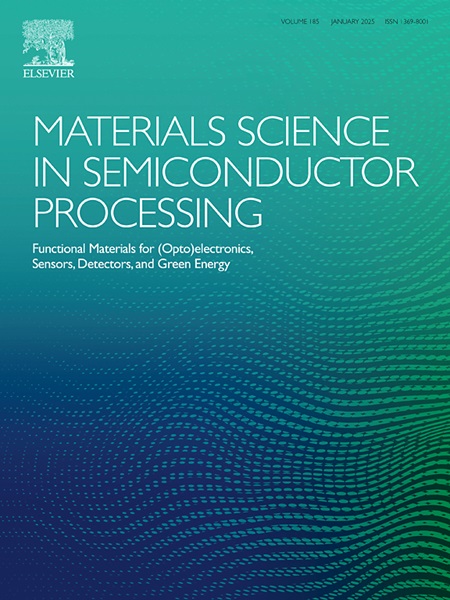用于深度传感和实时手势识别的自适应近红外光电探测器
IF 4.6
3区 工程技术
Q2 ENGINEERING, ELECTRICAL & ELECTRONIC
引用次数: 0
摘要
实时、节能传感技术的快速发展对于3D成像、手势识别和人机交互等领域的创新至关重要。然而,传统的光电探测器在连续监测过程中对光线突然变化的响应速度慢,功耗高,而事件传感器在检测瞬时变化方面表现出色,但在捕捉逐渐的强度变化方面效果不佳。为了解决这些关键限制,我们提出了一种“混合”近红外(NIR) Au/Ga2O3/n-Si/Au光电探测器,旨在同时检测瞬时事件和逐渐的光强变化。我们的单像素近红外光电探测器利用电容变化进行快速事件检测和在结处产生光电流,以监测连续的光变化。这种双功能架构允许在动态和静态环境中进行实时适应。我们进一步展示了它在实时z距离传感中的能力,集成了一个用于精确深度测量的深度神经网络。此外,混合单像素光电探测器促进实时手语识别,将手势翻译成文字,从而为人机交互提供了新的范例。通过弥合传统传感器和基于事件的传感器之间的差距,这种混合近红外设备不仅满足了下一代传感技术的需求,而且重新定义了物体分类、手势识别等领域的创新潜力。本文章由计算机程序翻译,如有差异,请以英文原文为准。
An adaptive near-infrared photodetector for depth sensing and real-time gesture recognition
The rapid evolution of real-time, energy-efficient sensing technologies is paramount for innovations in fields such as 3D imaging, gesture recognition, and human-machine interaction. However, conventional photodetectors are limited by their slow response to sudden changes in light and high-power consumption during continuous monitoring, while event sensors excel in detecting instantaneous changes but are ineffective at capturing gradual intensity shifts. To address these critical limitations, we present a ‘hybrid’ near-infrared (NIR) Au/Ga2O3/n-Si/Au photodetector, designed to simultaneously detect both instantaneous events and gradual light intensity variations. Our single-pixel NIR photodetector leverages capacitance changes for rapid event detection and photocurrent generation at the junction to monitor continuous light variations. This dual-functionality architecture allows for real-time adaptability in dynamic and static environments. We further demonstrate its capability in real-time z-distance sensing, integrating a deep neural network for precise depth measurements. Additionally, the hybrid single-pixel photodetector facilitates real-time sign language recognition, translating gestures into word, thereby offering a new paradigm in human-machine interaction. By bridging the gap between traditional and event-based sensors, this hybrid NIR device not only meets the demands of next-generation sensing technologies but also redefines the potential for innovation in the fields, such as in object classification, gesture recognition, and beyond.
求助全文
通过发布文献求助,成功后即可免费获取论文全文。
去求助
来源期刊

Materials Science in Semiconductor Processing
工程技术-材料科学:综合
CiteScore
8.00
自引率
4.90%
发文量
780
审稿时长
42 days
期刊介绍:
Materials Science in Semiconductor Processing provides a unique forum for the discussion of novel processing, applications and theoretical studies of functional materials and devices for (opto)electronics, sensors, detectors, biotechnology and green energy.
Each issue will aim to provide a snapshot of current insights, new achievements, breakthroughs and future trends in such diverse fields as microelectronics, energy conversion and storage, communications, biotechnology, (photo)catalysis, nano- and thin-film technology, hybrid and composite materials, chemical processing, vapor-phase deposition, device fabrication, and modelling, which are the backbone of advanced semiconductor processing and applications.
Coverage will include: advanced lithography for submicron devices; etching and related topics; ion implantation; damage evolution and related issues; plasma and thermal CVD; rapid thermal processing; advanced metallization and interconnect schemes; thin dielectric layers, oxidation; sol-gel processing; chemical bath and (electro)chemical deposition; compound semiconductor processing; new non-oxide materials and their applications; (macro)molecular and hybrid materials; molecular dynamics, ab-initio methods, Monte Carlo, etc.; new materials and processes for discrete and integrated circuits; magnetic materials and spintronics; heterostructures and quantum devices; engineering of the electrical and optical properties of semiconductors; crystal growth mechanisms; reliability, defect density, intrinsic impurities and defects.
 求助内容:
求助内容: 应助结果提醒方式:
应助结果提醒方式:


